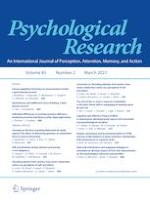27-11-2019 | Original Article
Dual-task interference and response strategies in simulated car driving: impact of first-task characteristics on the psychological refractory period effect
Gepubliceerd in: Psychological Research | Uitgave 2/2021
Log in om toegang te krijgenAbstract
Presentation of a task T1 typically delays the response to a subsequent task T2, more so with high temporal task overlap than with low temporal overlap. This so-called “psychological refractory period effect” (PRP effect) has been observed even if T1 required not a choice between distinct stimulus–response pairs, but rather between a given stimulus–response pair occurring once or twice. We explored which response strategy participants use for responding to such an unusual type of T1 and how such a T1 interacts with T2 performance. In a driving simulator, participants followed a lead car and had to honk when that car’s rear window changed color (T1). In condition “pure”, the color always changed once and required a single honk; in condition “mixed”, the color changed once and required a single honk on some trials, but on other trials, it changed twice 200 ms apart and required a double honk. Participants also had to brake when the lead car braked (T2). On dual-task trials, T1 preceded T2 with a varying stimulus onset asynchrony (SOA) of 50–1200 ms. Reaction time to the first T1 stimulus was similar in “pure” and “mixed” and it was comparable with the reaction time to the second T1 stimulus. Reaction time to the T2 stimulus increased as SOA decreased from 350 to 50 ms, confirming the existence of a PRP effect. Furthermore, reaction time to the T2 stimulus was similar in “pure” and in “mixed” with one T1 stimulus, but was higher in “mixed” with two T1 stimuli. This pattern of findings is compatible with the view that presentation of the first T1 stimulus triggers a single response, which is amended into a double response, if a second T1 stimulus is displayed. The amendment does not need to wait until central processing of the original response is completed, and it therefore begins with no delay beyond the regular reaction time. Our findings further suggest that the mere possibility of a second T1 stimulus being presented does not increase the PRP effect on T2, probably because response amendments are not equivalent to classical response choices. However, the actual presentation of a second T1 stimulus indeed does increase the PRP effect on T2, probably because amendments start 200 ms later than the original response, and therefore prolong central processing of T1.
